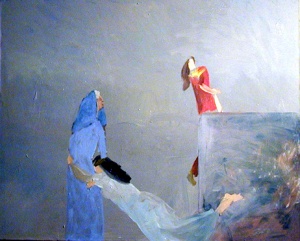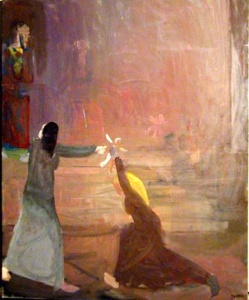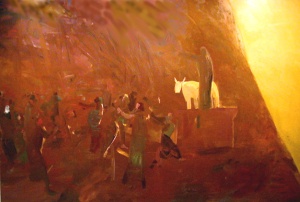Biblical Paintings – American Identity: An Appreciation
“And though I cannot attain to much herein, yet I am refreshed to have seen some glimpse thereof (as Moses saw the Land of Canaan afar off.) My aim and desire is to see how the words and phrases lie in the holy text; and to discern somewhat of the same for my own account.”
So writes Governor William Bradford in 1650 as he despaired over the travails of the Plymouth Plantation and his struggles with the Hebrew language. John Bradford, the painter, is descended from this founder of the Massachusetts Bay Colony. His forefather, Governor Bradford saw his struggling settlement in Massachusetts through the lens of the Bible, for him it was the Promised Land.
That conception of creating a new and moral society based on a Biblical vision built our American nation. John Bradford has a unique American perspective. He is a twentieth century Noahite, a unique non-Jew, and brings an intimacy and respect for the Torah that flows in his ancestral blood and ultimately allows him amazing freedom and creativity with the sacred text. Bradford’s exhibition of eight large new paintings at 55 Mercer Gallery is an example of the old American vision, updated in two important ways.
First of all as a Noahite he is commanded to acclaim God and His people, the Jews. This means he treats the Torah and its commentaries as his sacred and operative textual frame of reference. Second, by dint of his artistic upbringing, abstract expressionism (the consummate American pictorial expression) is his artistic methodology. Surface, gesture and subtlety of color and nuance dominate and make his works demanding aesthetic experiences. These are not easy paintings. Rather they must be absorbed, taken in slowly as visual poems where each seemingly causal line or stab of paint will yield an entire human figure and a whole personality. By the very lack of descriptive information he forces the viewer to pay close attention to the exact placement of figures and objects in the shallow pictorial space he provides. And, as always, the Biblical text is paramount.

A perfect example of this is his Ruth, Naomi and Orphah, over six by eight feet, that finds a pictorial equivalent to the moment that Ruth decides to convert and cling to her mother-in-law, Naomi. Ruth is slung across the divide from the surety of her former existence, symbolized by a simple block structure on the right attached to her crimson sister, Orphah. Naomi, distinguished only by a subtle shift in color from the background and a white headband seems shocked at this rash act. Ruth and Naomi are about to be cast adrift in the uncertain future of the nondescript background. How will they survive, this unlikely pair, in the hard times back in the Land of Israel? This narrative moment, normally seen as a paradigm of religious devotion (wither thou goest, I will go…), is understood here as but a prelude to the real agenda, ultimately securing a righteous matriarch for King David.
A stark contrast is provided in Egyptian Nights (Moses and the Rod before Pharaoh). Here Bradford evokes in dim light and shimmering pastel colors the fetid atmosphere of Pharaoh’s court. The air is thick and a strange luminary hangs in the sky. Tropical nature and mystery has suffused everything; Pharaoh himself merges into the blue palm trees behind him. Into this overheated environment Moses stands apart as a slash of crimson with just a slim triangle of a white robe peeking beneath his garment. Moses now enters into this mythic natural world as he thrusts the rod toward Pharaoh and it slithers into a snake. Moses is attempting to communicate in the magical mode Pharaoh will understand in order to make him hear the monotheistic message. The “cheap snake trick,” easily matched by Pharaoh’s magicians, is now revealed as a skillful diplomatic ploy to soften Pharaoh’s heart.

The heart of the narrative is frequently uncovered as Bradford works and re-works his paintings over many months and years. The Judgment of Solomon is a distillation of questions where King Solomon has been pushed to the extreme left edge of the painting and is no longer its focus. Rather the subject has become the relationship between the two mothers. One is upright and subservient to the king as she appeals to his royal wisdom. We notice that the entire lower center of the painting is dominated by the other mother. She holds the baby, a mere cipher of limbs in the physical and emotion center of the canvas, above her in supplication. Is she offering the child to King Solomon or is she passionately subjugating herself to the needs of the infant? The viewer is now forced to decide as we realize that the judgment here is not about rightful possession, rather the heart of the story is about the best interests of the helpless child.
Each figure, shape and gesture is carefully weighed and placed in these paintings that are obsessed with borders, edges and points of contact. Bradford has self-consciously heightened the tension of each object as it encounters a figure and as each figure touches another. These bounded groupings are constantly set within wide-open spaces that are amorphous and unknown, much like the experience of his Puritan forbearers as they faced the New England forests.

The Golden Calf, over nine by fourteen feet, is the largest painting in the show and raises the most questions. The massive shape of the mountain fills three-quarters of the surface until it is met by a luminous yellow triangle of sky at the right edge. A giant golden calf is set upon an imposing pedestal as the assembled mass of gesturing figures are glimpsed beneath the murky mountain. There are slashes of the same yellow light that catch an arm, a piece of clothing or the side of an anonymous face as if the light that emanates from the sky and illuminates the calf is also reflecting on the Children of Israel. Suddenly we notice an anomaly. A large figure is standing atop the pedestal; his silhouetted form divides the calf in half. This “everyman” character gestures over the calf as the people dance below. Is this Aaron in the final act of completion or Moses about to destroy the idol? The painting, which exists in the tension between these two aspects of the narrative, overwhelms us with a flurry of questions we must examine; is there a parallel between creator and destroyer, is the light, normally seen as Godly, also that which animated the calf and the people, and finally, are we all subject to the foibles of the Golden Calf as we seek a divine light?
I have known John Bradford for too many years to even attempt objectivity. We are fellow travelers who have shared the notion that the Biblical, as subject matter for art or as paradigm for politics, is central to understanding our contemporary condition. This road has been very fruitful.
Published by the Jewish Press